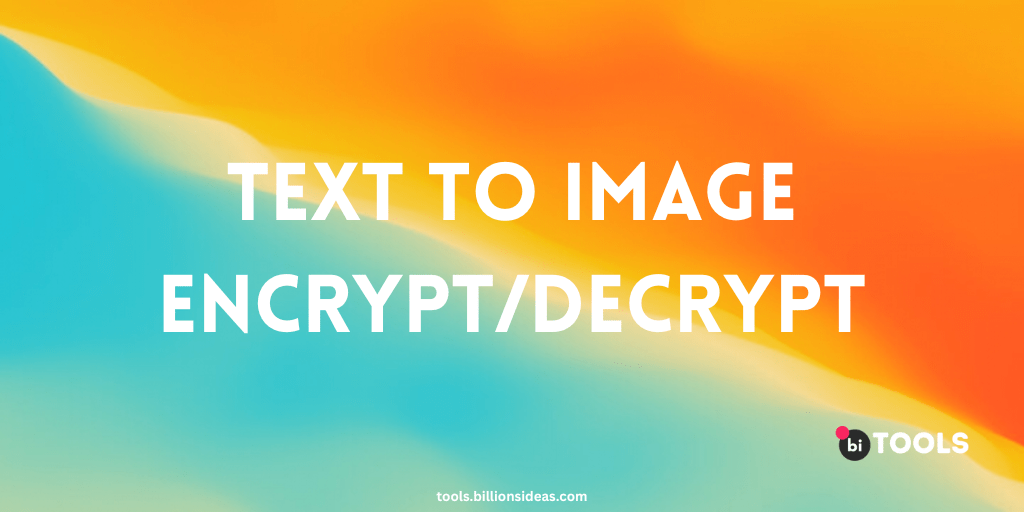Text & Image Encrypt Decrypt
Write something and click on Encrypt!
Or click to get some Lorem ipsum
Encrypt Now!
The image will appear in the below canvas, it’s very small you’ll have to right click and “save image as” to download the image
Contents
Decrypt Image To Text
Upload a PNG file created with this tool

In today's digital age, ensuring the privacy and security of our sensitive information has become crucial. One powerful technique that helps protect data from unauthorized access is image/text encryption. By converting data into an encrypted form that can only be deciphered with the right key, image/text encryption provides an added layer of protection against prying eyes. In this article, we will explore the concept of image/text encryption, how it works, its benefits, and practical applications.
What is Image/Text Encrypt?
Image/text encrypt is a process of converting plain text or images into a scrambled or encrypted form using algorithms and cryptographic techniques. This transformation makes the information unintelligible to anyone who doesn't possess the decryption key. Image/text encryption ensures that even if the encrypted data falls into the wrong hands, it remains unreadable and secure.
How Does Image/Text Encrypt Work?
Image/text encryption employs complex mathematical algorithms and encryption keys to convert the original data into ciphertext. The encryption key acts as a secret code that unlocks the encrypted data and allows it to be transformed back into its original form. There are two primary types of image/text encryption: symmetric and asymmetric encryption.
In symmetric encryption, the same key is used for both encryption and decryption. This key must be kept confidential between the sender and the recipient. Asymmetric encryption, on the other hand, uses a pair of keys: a public key for encryption and a private key for decryption. The public key can be freely shared, while the private key must be kept secure.
Benefits of Image/Text Encrypt
- Enhanced Security: Image/text encryption provides robust protection against unauthorized access, ensuring the confidentiality of sensitive information.
- Data Integrity: Encrypted data remains intact and unaltered during transmission or storage, maintaining its integrity.
- Regulatory Compliance: Image/text encryption helps organizations meet data protection standards and regulatory requirements.
- Selective Access: Encryption allows for selective access control, ensuring that only authorized individuals can decrypt and access the information.
- Peace of Mind: By encrypting data, individuals and organizations gain peace of mind knowing their confidential information is secure.
Online Image/Text Encrypt Tool
There are several online tools available for encrypting images or text. Here are a few popular ones :
- BI TOOL : BI TOOL is a cloud encryption software that supports file encryption, including images. It provides a secure and user-friendly interface for encrypting and decrypting files.
- Cryptii : Cryptii is a versatile online encryption tool that supports various encryption methods, including image encryption. It allows you to upload an image file and apply encryption algorithms like AES, RSA, or XOR.
- Online Text Encryption Tool: This tool focuses on text encryption rather than image encryption. It supports different encryption techniques such as Caesar cipher, ROT13, and more.
- IMGonline : IMGonline is specifically designed for image encryption. It lets you upload an image and apply encryption methods like XOR or grayscale.
Conclusion
In a world where data breaches are frequent and cyber threats are ever-present, image/text encryption serves as a crucial line of defense. By implementing robust encryption techniques and following best practices, individuals and organizations can safeguard their digital assets, maintain privacy, and mitigate the risks associated with unauthorized access.
FAQs
What is the difference between symmetric and asymmetric encryption?
Symmetric encryption uses the same key for both encryption and decryption, while asymmetric encryption uses two separate keys - a public key for encryption and a private key for decryption. Asymmetric encryption provides a higher level of security but is computationally more intensive.
Can image/text encryption be broken?
While image/text encryption provides strong protection, there is always a possibility of encryption being broken. However, the effectiveness of encryption depends on factors like key length, encryption algorithm strength, and key management practices. Strong encryption implemented with best practices significantly reduces the risk of decryption.
How is steganography different from other encryption techniques?
Steganography involves hiding information within an image or text file, making it inconspicuous. Unlike traditional encryption techniques, steganography conceals the existence of hidden data, providing an additional layer of security.
Is image/text encryption only used for security purposes?
Although image/text encryption is primarily used for security purposes, it has broader applications. Encryption can also be employed for digital rights management, ensuring integrity during data transmission, and protecting intellectual property.
What are the risks of not using image/text encryption?
Not using image/text encryption exposes data to various risks such as unauthorized access, data breaches, identity theft, and loss of intellectual property. Encryption acts as a safeguard against these risks, ensuring the confidentiality and integrity of valuable information.
